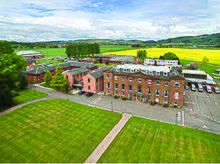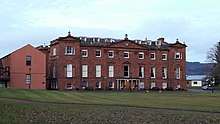Kilgraston School
Kilgraston School is an independent boarding and day school for girls aged 5–18. The school is centred upon a mansion house set in 72 acres (290,000 m2) of parkland, at Bridge of Earn, 3 miles (4.8 km) south of Perth and less than an hour's drive from Edinburgh. It is the only Catholic boarding secondary school in Scotland and is located within the Diocese of Dunkeld. The school has links with the boys' school Merchiston Castle School in Edinburgh and occasionally co-organises socials and functions together.[1] Kilgraston has thriving music and arts departments, hockey, tennis and swimming academies, and is Scotland's only school with an on-site equestrian centre. In 2013 Kilgraston was ranked fourth in the top Scottish schools by Advanced Highers.[2] Most recently in 2015, Kilgraston was named as the Sunday Times top performing independent school for Highers and Advanced Highers 2015.
| Kilgraston School | |
|---|---|
 | |
| Address | |
Bridge of Earn , PH2 9BQ Scotland | |
| Coordinates | 56.3414°N 3.416°W |
| Information | |
| Type | Independent day and boarding |
| Motto | Act with determination |
| Religious affiliation(s) | Roman Catholic |
| Established | 1930 |
| Founder | Society of the Sacred Heart |
| Local authority | Perth and Kinross |
| Headmistress | Mrs D MacGinty |
| Gender | Girls |
| Age | 5 to 18 |
| Enrolment | 275~ |
| Campus | Rural; 72 acres (290,000 m2) |
| Website | www |

Junior Years (ages 5–12), Senior School (ages 13–16) and Sixth Form. It is a member of the Girls' Schools Association.
History
Building
Kilgraston's earliest records date back to the 13th century where it was called Gilgryston. John Grant, the eldest son of Patrick Grant of Glenlochy, in Strath Spey, Inverness-shire, and whose principal wealth was made in Jamaica, was for several years a member of the Assembly there, becoming an assistant Judge of Jamaica's Supreme Court, and eventually succeeded Thomas French as Chief Justice of that island in January 1783, which office he held until 1790. Also, in 1783, he was confirmed as an armiger by the Lord Lyon King of Arms. Grant purchased, towards the end of the 18th century, from the Murray and Craigie families, the contiguous estates of Kilgraston and Pitcaithly, situated in the east end of the beautiful and rich valley of Strath Earn, and extending over part of the Ochil Hills. He died issueless at Edinburgh on 29 March 1793, and is buried under a marble tablet in St Cuthbert's Churchyard. He was succeeded in his estates by his brother Francis (d. 1819, who built the mansion. The mansion was used as a private home until World War I during which it was used as a hospital.
School
In 1930 the house and grounds were purchased by the Society of the Sacred Heart and opened as a school with 40 boarders. The Society ran the school as a charitable trust until 2000 when it became an independent school.[3] It briefly participated in the Assisted Places Scheme during the 1990s until its abolishment.[4] In 2003, it absorbed the nearby all-girls Butterstone Prep School due to the latter's financial difficulties. Its girls were transferred 22 miles to Kilgraston and one of the boarding houses was named Butterstone after the school.
Capital investments have included the opening of a 25m indoor swimming pool complex and upgrades to the equestrian centre (Kilgraston is the only school in Scotland with equestrian facilities on campus) including a 60m x 40m floodlit arena) and a new international sized all-weather floodlit hockey pitch. Other developments have been a new theatre with retractable seating for 150, a bistro style dining room, sports pavilion as well as an ongoing upgrade of the residential facilities. As a member of the Network of Sacred Heart Schools, there are exchange and twinning programmes available for girls to interact with fellow students from sister schools around the world. Sixth Form pupils now have access to their own study centre with individual work stations. In 2014, Professor Yellowlees, Chair of the Royal Society of Chemistry and Vice President and Head of the School of Science and Engineering at Edinburgh University, formally opened Kilgraston's £1million Science Centre.
In January 2012, Kilgraston was named "Independent School of the Year" ahead of 27 other independent schools across Britain at the Independent School Awards. It was also nominated for the Outstanding Strategic Initiative Award in recognition of the changes the school has made to achieve 55% growth in the last five years and received the Outstanding Financial Initiative prize for its £2m investment in facilities and the introduction of a number of Sports Academies.[5]
Academics
Kilgraston has a strong academic record in examination league tables. The school was recently named the top performing independent school for Advanced Highers (AH) 2016 by best-schools. In 2015, the school was Sunday Times top performing independent school for Highers (H) and Advanced Highers (AH) 2015. In August 2016, 65.5% of grades at AH were A grades against a national average of 33.5%. 90.5% of grades were A-B against a national average of 59.3% and 36% of girls are now studying a STEM undergraduate course. 100% of girls in 2016 were accepted into their choice of university.
Boarding
Boarding is available to girls aged 8 and above. Approximately half of pupils are boarders, most of whom board on weekdays or on flexible arrangements. The girls reside in three boarding houses: Butterstone (Junior Years),[6] Mater (Senior School)[7] and Barat or Swinton (Sixth Form).[8] Senior School and Sixth Form boarders have their own bedrooms.
Former staff and pupils
- Louise Baxter, former Scotland international hockey player and Head of PE[9]
References
- "School of excellence: Kilgraston School". The Scotsman. 22 April 2008.
- Best Scottish Schools by Advanced Highers
- History
- "Assisted Places Scheme". Parliamentary Debates (Hansard). House of Commons. 13 July 1995. col. 729–737W.
- "Award-winning Perthshire school sees girls boarding bucking trend and booming". gsa.uk.com. 19 January 2012. Archived from the original on 11 February 2012.
- "Prep Boarding". Archived from the original on 27 April 2012. Retrieved 15 May 2012.
- Senior School Boarding
- Sixth Form Boarding
- "Schools hockey: Katie Robertson and Louise Baxter join forces". The Scotsman. Johnston Press. 5 February 2013. Retrieved 5 April 2015.
Sources
- Burke, John, Esq., A Genealogical History of The Commoners of Great Britain and Ireland enjoying Territorial Possessions or High Official Rank, London, 1835, volume II, p. 613.
- Smith, John, & Balfour Paul, Sir James, editor, Monumental Inscriptions in St. Cuthbert's Churchyard, Edinburgh, Scottish Record Society, Edinburgh, 1915, p. 13.
External links
| Wikimedia Commons has media related to Kilgraston School. |
- School Website

- Profile on the Independent Schools Council website
- Profile on MyDaughter
- Profile on Scottish Schools Online
- Profile on The Good Schools Guide
- 2011 HMIE Inspection Report